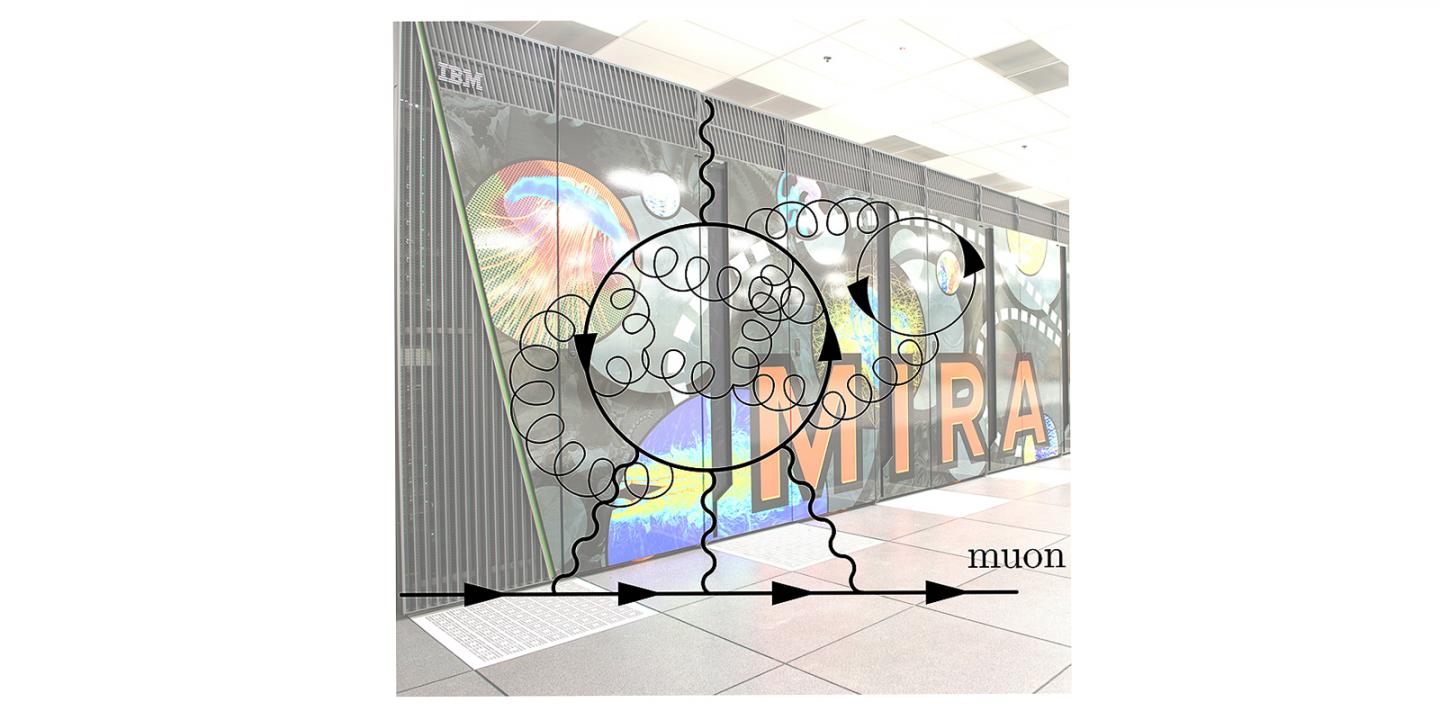For two decades, physicists have been trying to reconcile a gap between theoretical and experimental data on a particle called the muon. A new study, powered by Argonne Lab’s supercomputer Mira, sharpens one piece of the puzzle.

Credit: Photo courtesy of Luchang Jin, University of Connecticut
UPTON, NY and LEMONT, IL—Two decades ago, an experiment at the U.S. Department of Energy’s (DOE) Brookhaven National Laboratory pinpointed a mysterious mismatch between established particle physics theory and actual lab measurements. When researchers gauged the behavior of a subatomic particle called the muon, the results did not agree with theoretical calculations, posing a potential challenge to the Standard Model—our current understanding of how the universe works.
Ever since then, scientists around the world have been trying to verify this discrepancy and determine its significance. The answer could either uphold the Standard Model, which defines all of the known subatomic particles and how they interact, or introduce the possibility of an entirely undiscovered physics. A multi-institutional research team (including Brookhaven, Columbia University, and the universities of Connecticut, Nagoya and Regensburg, RIKEN) have used Argonne National Laboratory’s Mira supercomputer to help narrow down the possible explanations for the discrepancy, delivering a newly precise theoretical calculation that refines one piece of this very complex puzzle. The work, funded in part by the DOE’s Office of Science through its Office of High Energy Physics and Advanced Scientific Computing Research programs, has been published in the journal Physical Review Letters.
A muon is a heavier version of the electron and has the same electric charge. The measurement in question is of the muon’s magnetic moment, which defines how the particle wobbles when it interacts with an external magnetic field. The earlier Brookhaven experiment, known as Muon g-2, examined muons as they interacted with an electromagnet storage ring 50 feet in diameter. The experimental results diverged from the value predicted by theory by an extremely small amount measured in parts per million, but in the realm of the Standard Model, such a difference is big enough to be notable.
“If you account for uncertainties in both the calculations and the measurements, we can’t tell if this is a real discrepancy or just a statistical fluctuation,” said Thomas Blum, a physicist at the University of Connecticut who co-authored the paper. “So both experimentalists and theorists are trying to improve the sharpness of their results.”
As Taku Izubuchi, a physicist at Brookhaven Lab who is a co-author on the paper, noted, “Physicists have been trying to understand the anomalous magnetic moment of the muon by comparing precise theoretical calculations and accurate experiments since the 1940s. This sequence of work has led to many discoveries in particle physics and continues to expand the limits of our knowledge and capabilities in both theory and experiment.”
If the discrepancy between experimental results and theoretical predictions is indeed real, that would mean some other factor—perhaps some yet-to-be discovered particle—is causing the muon to behave differently than expected, and the Standard Model would need to be revised.
The team’s work centered on a notoriously difficult aspect of the anomaly involving the strong force, which is one of four basic forces in nature that govern how particles interact, along with weak, electromagnetic, and gravitational force. The biggest uncertainties in the muon calculations come from particles that interact through the strong force, known as hadronic contributions. These hadronic contributions are defined by a theory called quantum chromodynamics (QCD).
For a long time, many people thought this contribution, because it was so challenging, would explain the discrepancy. But we found previous estimates were not far off.
— University of Connecticut physicist Thomas Blum
The researchers used a method called lattice QCD to analyze a type of hadronic contribution, light-by-light scattering. “To do the calculation, we simulate the quantum field in a small cubic box that contains the light-by-light scattering process we are interested in,” said Luchang Jin, a physicist at the University of Connecticut and paper co-author. “We can easily end up with millions of points in time and space in the simulation.”
That’s where Mira came in. The team used the supercomputer, housed at the Argonne Leadership Computing Facility (ALCF), to solve the complex mathematical equations of QCD, which encode all possible strong interactions with the muon. The ALCF, a DOE Office of Science User Facility, recently retired Mira to make room for the more powerful Aurora supercomputer, an exascale system scheduled to arrive in 2021.
“Mira was ideally suited for this work,” said James Osborn, a computational scientist with the ALCF and Argonne’s Computational Science division. “With nearly 50,000 nodes connected by a very fast network, our massively parallel system enabled the team to run large simulations very efficiently.”
After four years of running calculations on Mira, the researchers produced the first-ever result for the hadronic light-by-light scattering contribution to the muon anomalous magnetic moment, controlling for all errors.
“For a long time, many people thought this contribution, because it was so challenging, would explain the discrepancy,” Blum said. “But we found previous estimates were not far off, and that the real value cannot explain the discrepancy.”
Meanwhile, a new version of the Muon g-2 experiment is underway at Fermi National Accelerator Laboratory, aiming to reduce uncertainty on the experimental side by a factor of four. Those results will add more insight to the theoretical work being done now.
“As far as we know, the discrepancy still stands,” Blum said. “We are waiting to see whether the results together point to new physics, or whether the current Standard Model is still the best theory we have to explain nature.”
Argonne National Laboratory seeks solutions to pressing national problems in science and technology. The nation’s first national laboratory, Argonne conducts leading-edge basic and applied scientific research in virtually every scientific discipline. Argonne researchers work closely with researchers from hundreds of companies, universities, and federal, state and municipal agencies to help them solve their specific problems, advance America’s scientific leadership and prepare the nation for a better future. With employees from more than 60 nations, Argonne is managed by UChicago Argonne, LLC for the U.S. Department of Energy’s Office of Science.
One of ten national laboratories overseen and primarily funded by the Office of Science of the U.S. Department of Energy (DOE), Brookhaven National Laboratory conducts research in the physical, biomedical, and environmental sciences, as well as in energy technologies and national security. Brookhaven Lab also builds and operates major scientific facilities available to university, industry and government researchers. Brookhaven is operated and managed for DOE’s Office of Science by Brookhaven Science Associates, a limited-liability company founded by the Research Foundation for the State University of New York on behalf of Stony Brook University, the largest academic user of Laboratory facilities, and Battelle, a nonprofit applied science and technology organization.
The U.S. Department of Energy’s Office of Science is the single largest supporter of basic research in the physical sciences in the United States and is working to address some of the most pressing challenges of our time. For more information, visit https:/
Follow @BrookhavenLab on Twitter or find us on Facebook
Media Contact
Karen McNulty Walsh
[email protected]
Original Source
https:/
Related Journal Article
http://dx.





